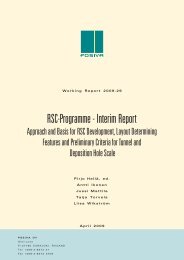Bentonite Mineralogy Part 1: Methods of Investigation - Posiva
Bentonite Mineralogy Part 1: Methods of Investigation - Posiva
Bentonite Mineralogy Part 1: Methods of Investigation - Posiva
You also want an ePaper? Increase the reach of your titles
YUMPU automatically turns print PDFs into web optimized ePapers that Google loves.
Table 3-2. Reported values <strong>of</strong> relative intensifies, given by equal amounts <strong>of</strong> minerals<br />
(Olsson, 1991).<br />
14<br />
Author/miner. Pia g. K-fs Quartz Afb Chlorite Illite Verm. mount<br />
peak 3,19A 3,25A 3,34A 4,26A 8,3A 7A t4A lOA t4A<br />
Schultz ( 1964) 1 1 2 R<br />
Snall et al.<br />
(1979) 1 1 3 1 6 2 4 0<br />
Backman et al.<br />
(1986) 3 1 2 R<br />
Islam&Lotse<br />
(1986) 0,5 0,5 0,5 2,2 1 2,5 0<br />
Pederstad&<br />
Jorgensen<br />
(1985) b b b 2 1 3 0<br />
Roaldset<br />
(1978) 3 1 1 1 2 1 0<br />
Jorgensen<br />
(1965) 1 0,3 0,3 1 0<br />
Melkerud<br />
(1983) 1 0,8 0,3 1 6 2 4 O+R<br />
Olsson (1991) 1,3 1 0,6 0,8 0<br />
Legend: Plag., plagioclase; K-fs, potassium feldspar; Afb, amphibole; Verm., vermiculite;<br />
mount, XRD mount, random (R) or oriented (0).<br />
b, the authors used equations: wK-Js/Wq = 0,97 x IK-Js/Iq- 0,04; Wp/wq = 0, 79 x Ip/Iq-0,07.<br />
An example: A mixture <strong>of</strong>plagioclase, K-feldspar and quartz, peak intensity <strong>of</strong> each is<br />
100 (quartz 4,26A peak). According to Islam and Lotse the mixture contains 33,3% <strong>of</strong><br />
each mineral, according to Roaldset and Jorgensen 14,3% plagioclase, 42,9% Kfeldspar<br />
and 42,9% quartz, according to Melkerud 17,9% plagioclase, 22,4% K-feldspar<br />
and 59,7% quartz and according to Olsson 22,4% plagioclase, 29,1% K-feldspar and<br />
48,5% quartz.<br />
At the Research laboratory <strong>of</strong> the Geological Survey <strong>of</strong> Finland, factors used for<br />
evaluation <strong>of</strong> mineral composition were calculated from patterns <strong>of</strong> mineral pairs with<br />
known proportions <strong>of</strong> each mineral (Table 3-3). S<strong>of</strong>tware determined the base line and<br />
the peak heights that were used for calculation <strong>of</strong> the factors. In most cases, quartz was<br />
one <strong>of</strong> the minerals and the intensity <strong>of</strong> its 4,26 A peak was taken as 1. The smectite<br />
used was montmorillonite from Wyoming. Using the factors from table 3-3, following<br />
percentages are received for the sample above: either 27,3% plagioclase, 27,8% Kfeldspar<br />
and 44,8% quartz or 37,2% plagioclase, 24% K-feldspar and 38,8% quartz,<br />
depending on the composition <strong>of</strong> plagioclase.

















